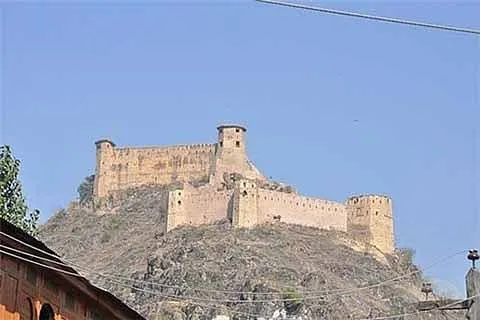One of the important symbols of Srinagar is Hari Parbat, built on a hill located on one side of the Dal-lake. It is also popular by the name Koh-e-Maraan. The name Hari Parbat is derived from an ancient legend. There was a time when the valley was full of demons.
One such demon was Asura Jalobhava. The local Hindus prayed to Parvati (Lord Shiva’s wife) for help. She took the form of a Myna (Haer in Kashmiri), a bird of the Starling family (Sturnidae), native of South Asia; the Myna dropped a pebble on the Asura’s head.
This pebble became larger and larger until it crushed the demon. That large stone now coated with vermilion is considered as a symbol of Parvati and is worshipped as Sharika (cosmic energy pervading the universe).
It occupies middle part of the western slope of the hill where there is a temple of Shakti, who is worshipped under the familiar name of Jagdamba Sharika Bhagwati.
She is depicted as having 18 arms and sitting in Shri Chakra (Chakreeshwar). This ancient temple is a very revered place for Kashmiri Pandits. The best time to go there is very early in the morning.
In the days pre-1990, before the unfortunate Pandit exodus, one could see a large number of devotees with vermilion teekas (Tyok in Kashmiri) on their foreheads going up and down the hill.
The first fortification of this site was done in 1590 by the Moghul emperor Akbar. He got an outer wall built in the form of a fort. It was a part of his plan to make a new capital at the site where the present city of Srinagar is located.
This project never got completed. The present fort was built in 1808 under the Afghan regimen during the Durrani empire. The Governor of Kashmir those days was Atta Mohammed Khan. The fort can be entered through two gates. One, the Kathi Darwaza near Rainawari, and the other near Hawal through Sangeen Darwaza.
The Southern side of Hari Parbat features the shrine of the Sufi saint Hazra Makhdoom, a 16th century saint later known as Makhdoom Sahab (1494- 1578). He was a mystic Sufi saint living in Kashmir often referred to as Mehboob-ul-Alam (loved by all).
He was born in village near Sopore. His father was born in a Rajput Chandravanshi family and was famous as Baba Usman. As per the history Hamza Makhdoom studied in Shamsi Chak monastery and later was educated in jurisprudence, philosophy and mysticism in Ismail Kubrawal’s Madrassa.
He directed his teachings specifically to the followers of Islam, and under his influence a part of Kashmir’s population truly followed the Sunni Islam. He passed away at the age of 82 and his shrine is located on the Southern slope of Hari Parbat hill.
This is an important pilgrimage centre for Kashmiris. Built below the fort is a mosque dedicated to Shah Badakhshi a 17th century Qadiri Saint. The mosque was built by Mughal princess Jahanara Begum.
Another revered place on the foothills of Hari Parbat is a historic Gurudwara called the Chatti or Chhevin Padshahi. The 6th Guru, Guru Gobind Singh, while preaching the teachings of Guru Nanak stayed at this place for a few days.
This place was also visited by Guru Nanak and Guru Hargobind. The Gurudwara is located outside the Kathi Darwaza at the site of the house of Mai Bhagbari who had been long waiting to have a glimpse of the Guru when Hargobindji fulfilled her wish and wore her now famous gown. There is a well nearby which is supposed to have been dug on the instructions of Guru Hargobind.
The Gurudwara has a large rectangular hall with a central sanctum. A big Gurudwara has been constructed there with a traditional yellow flag with the Sign of Khalsa in the middle, the Nishaan Sahab. There is an annual event on the day when Guru Hargobind had visited the place called the “Prakash Utsav”.
Around the clock free food arrangement “Langar” is available. The fort today is under the use of Central reserved Police and Rashtriya rifles like many other historic places in the valley. Under the directives of the central government the Indian tricolour was hoisted on 15th August 2021 on the top of the fort .
The foothills are also known for the spring festival of almond blossom “Badam waree”. Whole area is full of lovely flowers adorning the almond trees, and heralds the end of winter in the valley. People come out for picnics during this time.
Tail Piece:
Hari Parbat or Koh e Maran is a symbol of Kashmir valley, visible clearly from the Dal-lake area. Its name is associated with many legends. The fort has been made during the reign of Moghuls and then finalised by Afghan Durrani rulers. Its western part has very important places of worship for Pandits, Muslims and Sikhs. It is a part of the civilisation of our valley and a living example of our composite culture.
Prof Upendra Kaul is founder Director of Gauri Kaul foundation. Recipient of Padma Shri and Dr B C Roy Award.
Disclaimer: The views and opinions expressed in this article are the personal opinions of the author.
The facts, analysis, assumptions and perspective appearing in the article do not reflect the views of GK.







